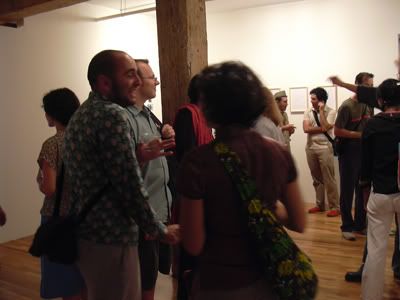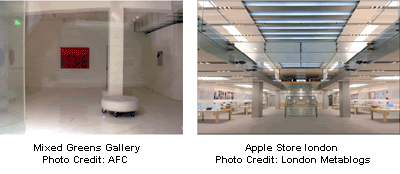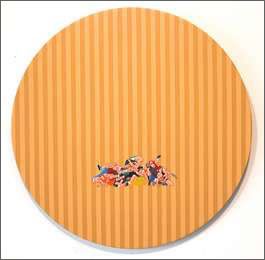Thursday night Chelsea officially opened for business, and after a long summer break, the mob scene that ensued was fairly predictable. Although most gallery openings run from six to eight, the streets were full until well after nine. Truly, there a few better opportunities for people watching in the city than this.

Leopold Kessler, Transportable Works at Lombard Freid Projects. Photo credit: AFC
Evenings such as these are likely to be great fun because you inevitably run into 500 people you know. That is, if they were all people you cared to know. Openings often end up being an exercise in complacent head nodding, which sucks, because really, I don’t care about a) the work you say you are making in your studio and aren’t, or b) your paintings which explore biomorphic forms and ideas of intrusion and extrusion. Fuck me. The need to reinvestigate 1999 aesthetics is almost as important as rewatching a VH1 “I love the 90’s” special. Almost.
But, on to the subject at hand. AFC spent the majority of the evening with Mixed Greens Gallery. This is a relatively new gallery (founded in 1999) that has earned a reputation for it’s lack of pretension and dedication to seeking out quality work among young artists. 2005 brought more change than usual for Mixed Greens since they moved locations. They did only move a block though, so really, we’re only talking about architectural differences here. No longer in the Starrett Lehigh building, the space on 26th now looks like the art version of an Apple Store, which as we all know has “down to earth” written all over it. But, you know, at least it looks good. As do all things Apple.

Now, there would be little point in going over the Galleries lease history for the last year, if there wasn’t something to say about the show they opened Thursday night. And indeed there is, as Mixed Greens wins the AFC prize for best opening show with A.A. Rucci in their south gallery (Rudy Shephard showed in their north gallery, but AFC did not make it to that end of the gallery so a review that work will have to wait). The artist’s paintings are beautiful, whimsical, and decorative, (assuming it is still possible to pen this word without evoking entirely negative connotations and a discussion on Matisse) .

AA Rucci. The celebration broke into pandemonium
upon Nicola’s announcement of her engagement
to Bryan. (2004)
Photo Credit: Mixed Greens Gallery
Like the painting shown above, the body of work typically features small figures in action and/or erotic poses against large backgrounds. Given a scale formula such as this, I have to say, it’s almost impossible to make something that looks bad which, is a problem in and of itself. In many ways the real success of the work is illustrated by the fact that it doesn’t look divisive. The reasons for this are complex and many, but we can boil it down and to say that there lot more at play then just formalism. Well thought out decisions such as leaving the figures headless, and pointed titling give the viewer a lot more to think about. The narratives Rucci creates are charged with emotional intensity, and rely almost exclusively on the figure and figure ground relationship to communicate these things.
As is sometimes the case with artists, Rucci’s objectives, while they seem to be clear in his studio practice, do not match up with the goals he has articulated in his statement. This can mean one of two things, a) that his objectives have been articulated after the work is completed and he is simply not a writer or b) that his objectives are not being met, and his work has yet to mature. I suspect it is a combination of these things, but to what degree is hard to say at this point.
Rucci’s statement reveals that he has decapitated the figures so that the audience can better identify with characters.
I am not, however, trying to write the story alone. I invite the viewer to take part in the still-unfolding storylines, offering one the opportunity to act as co-Author and complete the script. Thus, the realistic diminutive figures are not to be regarded as decapitated but rather as characters to be completed by the spectator/participant. By leaving the figures headless, my willing collaborators can cast whomever they choose in each role and write the accompanying scenes accordingly. -AA Rucci
If this is indeed the genuine interest of the artist, he might try a different track, since I don’t know of too many people who find narrative collaboration easier simply because the heads have been left off of painted figures. Moreover, the narrative collaboration assumes either a male spectator, or a wet dream female viewer who loves completeing narratives about girl on girl fantasies. All of this aside, the real problem I have with spectator collaboration in the discipline of painting, is that the concept sounds inherantly bullshitty. Interpretation is not so important that it means collaboration — it is just independant thought.
There is probably little point in going through Rucci’s statement for more of this type of thing, since there is a lot of it and the work stands better on it’s own. Personally, what I think what is interesting about the headless figures, is the inevitable reference to any number of Greek and Roman statues of athletes who lost their heads over the course of history, in addition to the stylistic references made to illustrated manuscripts. The beauty of Rucci’s work is that because these figures lack heads they have no way to speak or hear, and thus they are resoundingly quite against the sound of history.


{ 2 comments }
Terrific post. The analysis of the space between goals and execution is excellent. I am not familiar with Ricci’s work, but I’ll look for more of it.
Terrific post. The analysis of the space between goals and execution is excellent. I am not familiar with Ricci’s work, but I’ll look for more of it.
Comments on this entry are closed.